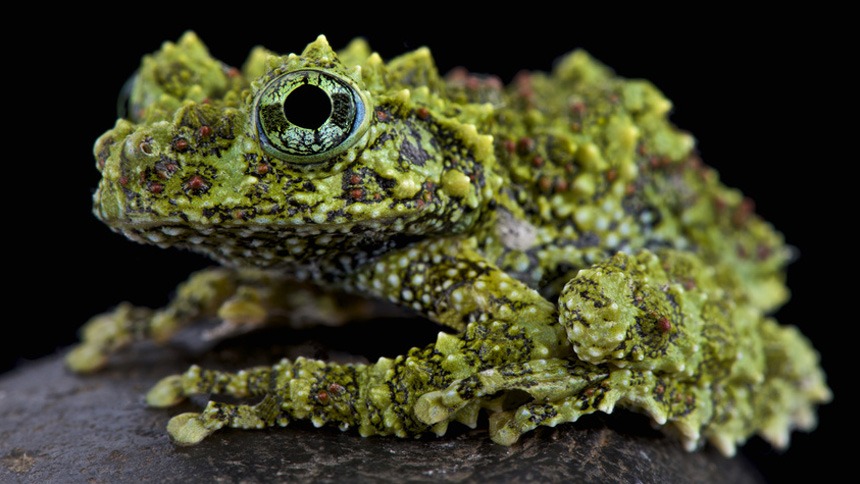
Vietnamese Mossy Frog Care Sheet & Pet Guide
Also known as Warty Frogs and Bug-eyed Frogs (Theloderma corticale)
The Theloderma corticale or Vietnamese mossy frog is one of the best-camouflaged species in the world. Their coloration and bumpy dermis give the appearance of a patch of moss, making them a great display pet.
Keeping one in captivity, however, is not recommended for beginners unless ample research is conducted before buying. Caring for a Vietnamese mossy frog requires daily attention and the proper cage setup.
Their natural habitat is fairly simple to replicate. Filling the bottom of a glass tank or terrarium with a few inches of water and adding some natural cork bark for a land area is common. They require high humidity, weekly cleaning, a day and night cycle, and appropriately sized crickets dusted with vitamins and minerals.
At the time of writing this care sheet, the lifespan of Vietnamese mossy frogs is largely unknown. You can, however, expect at least 10 years of life or more. The Rosamond Gifford Zoo reports a lifespan of 12 – 15 years in captivity.
A fully matured Vietnamese mossy frog can grow up to 2.5 – 3.5 inches in length. At the higher end of the scale are the adult female Theloderma corticale. Males are generally smaller overall, having slender legs, body, and head.
Page Contents
In the Wild
The Vietnamese mossy frog, as their name suggests, hails from Vietnam. To be more specific, they are usually found in the northern regions of Vietnam in evergreen rainforests along limestone cliffs. This species enjoys living in rocky areas surrounded by vegetation and water.
Since they’re semi-aquatic, you can find Vietnamese mossy frogs inside watery caves, hiding under rocks and around mossy plants. These conditions are the perfect background for mossy frogs to blend in with. Their overall appearance looks like a clump of moss. Theloderma or “mossy frog” translates as “bumpy skin”. Their dermis, or skin, is described as bumpy or “warty” with a green and red coloration. Their amazing camouflage it makes them nearly impossible to see when they are not moving.
Aside from their camouflage, the Vietnamese mossy frog has another tactic for avoiding unwelcomed predators. When frightened they will fold into a ball and play dead.
Vietnamese Mossy Frog Cage Setup
When housing a Vietnamese mossy frog, a general rule-of-thumb is about 10-gallons per frog. Some keeper suggests a 10-gallon minimum with an additional 5 gallon per frog in the enclosure.
An aquarium or glass terrarium with a screen lid is recommended and keeping 2 – 4 of them in one tank is not only acceptable but recommended. They are semi-aquatic frog species that require a large bowl of water or full or partial water bottom and moderate to high humidity.
- Appropriately sized glass aquarium or terrarium
- A large bowl of water or full water bottom
- Tannin-rich water
- Floating food bowl
- Natural cork bark or similar land structure
- Hides or cover – usually accomplished with cork bark and decorations.
Both live and fake plants are acceptable and since this species is nocturnal, special lighting is not required. Lighting is, however, required for live plants but, like is said, Vietnamese mossy frogs do not need lighting to remain healthy.
As for the cage dimensions, a 24″ x 18″ x 18″ terrarium (roughly 30 gallons) is large enough for 2 – 4 frogs while something a little smaller, like 18″ x 18″ x 18″ is good for 2 Vietnamese mossy frogs. Similar sized aquariums and tanks are perfectly acceptable. Bigger tanks are also good!
Lighting
As I mentioned above, Vietnamese mossy frogs don’t require special lighting themselves. You will, however, need lighting if you chose to use live plants. Those red or blue “nightlights” can be used at night for watching your pet when it’s most active. Be sure, however, that you do not confuse this with a heat lamp. Check the temperature section for more information.
Temperature
Keeping Vietnamese mossy frogs at room temperature is common-practice. Temperatures between 65 – 75 degrees Fahrenheit are suggested. Occasional drops in temperature below 60 ° F haven’t been known to hurt this particular species since their natural habitat is fairly cool. Higher temperatures, or anything above 80 degrees Fahrenheit, is dangerous and will result in stress and possibly death.
Substrate
Choosing a substrate for your Vietnamese mossy frog is fairly easy. Since they’re semi-aquatic, they require both land and water. Some keepers choose to fill their enclosure with 2 – 4 inches of water and place natural cork bark around the cage. This gives them places to hide and creates a dry, land-like area for sitting and climbing.
Hard-scape items like rocks and medium-sized gravel are another option. You can get as elaborate as you want. Creating a naturalist vivarium with rocks, cork bark, gravel, live plants and real moss is perfectly acceptable for Vietnamese mossy frogs.
When creating a vivarium using live plants, a soil-mixture substrate is needed. It is important to do your homework first. Soggy soil that is not properly drained will cause problems for your plants and frogs.
The long-and-short of it is this: provide some land and water areas with several places to hide.
Water Quality
Vietnamese mossy frogs thrive in tannin-rich water high in organics. Water too clean can be harmful but you shouldn’t allow it to get too dirty. Tea-colored water is common and I suggest adding an Indian almond tree leaf as well. Safe, dechlorinated water is a must for all frogs while doing a partial water change (up to half the water) once every two weeks. For an in-depth guide to providing safe water for amphibians, click here.
- Dechlorinated water
- Partial water change every-other-week
- Use a tannin-rich organic like Indian almost leaves
- The enclosure should have 2 – 4 inches of water
As mentioned above, I suggest adding an Indian almond tree leaf or other tannin-rich organics. Magnolia or oak leaves work as well. In the wild, Vietnamese mossy frogs live in bodies of water with soil, tree roots and other organic matter. Tree leaves fall into the water and decompose, releasing tannins into the water. This lowers the pH and turns the water a murky, yellow or brown color.
Alternatively, blackwater extract is a popular item used by frog enthusiasts across the world. You can buy blackwater extract online or at your local pet store.
The water quality section would not be complete without mentioning the harmful effects that chlorine has on all amphibians. Regular tap water, in most cases, is harmful to frogs. There are, however, a couple methods of solving this problem.
- Letting the water sit for 24 hours will dechlorinate it.
- Water conditioners like ReptiSafe is a quick, safe method for dechlorination.
- Using bottled water instead of tap water is the best option.
Remember to do a partial water change at least once every-other-week but don’t clean the water too much, as that can also be harmful to Vietnamese mossy frogs.
Humidity
The recommended humidity is between 60% – 90%. Because they’re semi-aquatic, part of their tank will be filled with water which adds to the humidity in their enclosure. Unfortunately, this alone will not keep the humidity high enough. Misting the cage two to three times per week will suffice.
Moisture retaining substrates can help as well. Another option is to cover part of the screen lid with a sheet of plastic or a piece of glass that covers roughly 75% of the top of their tank.
Consider using an automated misting system or a fogger. If you’re still having problems, see this guide on how to raise the humidity in your terrarium.
Paludariums
Because mossy frogs require both land and water, many keepers opt for creating a naturalistic cage setup with live plants, moss, fish, and of course, their pet mossy frogs. It’s important to remember your pet’s needs first then build around that. Creating a functional mini-biome is an entire topic in and of itself, and I won’t bother explaining everything here. I will, however, suggest a few frog-friendly fish and plants in the sections below.
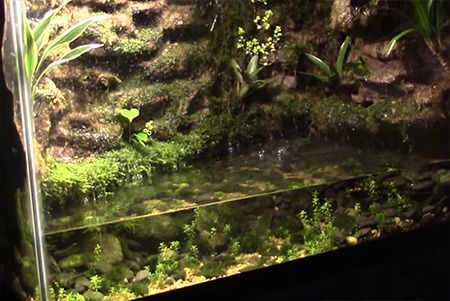
Plants
Before placing live plants in your Vietnamese mossy frog’s tank, you should rinse them with dechlorinated water to remove unwanted contaminants. Another thing to keep in mind is the size of the tank and the size of the plants. I suggest adding small plants that grow slowly, as it reduces the amount of maintenance.
- Live Moss – Seeing as this species of frog is named after it, moss is an obvious choice for a terrarium. Moss, however, tends to be more difficult to keep alive. Placing moss on a substrate with good drainage helps. Pillow moss is another popular one.
- Peace Lily – The leaves of a peace lily look somewhat generic in my opinion. But that’s not the reason I’ve suggested it. It’s the roots that attract most people to this particular plant. Peace Lily’s help to create that shoreline terrarium look with roots stretching out into the water.
- Golden Pothos – this is a common plant found in reptile terrariums. It’s a vine which is typically planted directly into the background but can also be planted into the substrate.
Fish
There are a number of small, peaceful fish that will fit nicely into your Vietnamese moss frog’s paludarium. One only needs to do a quick google search to find a list of potential candidates. I’m keeping this section short and sweet, and only offering a few suggestions. My favorites are zebra danios, tetras, and white cloud mountain minnows.
Wood
Avoid terrarium branches and logs that are high in tannins if you want to keep the water as clean as possible. Otherwise, just be sure to get sturdy branches! A few pieces of Spiderwood will fit nicely because they’re low in tannins, provide lots of hiding areas, and they look great!
Vietnamese Mossy Frog Diet
Vietnamese mossy frogs are nocturnal insectivores. This means their diet consists of insects like crickets, worms, roaches and other invertebrates in the wild. And because they’re nocturnal, eating occurs at night when they’re most active. It’s important to replicate their natural feeding environment as best as possible. While its basically impossible to feed your mossy frog all the different types of insects they would eat in the wild, it is entirely possible to keep them healthy by feeding them crickets dusted with vitamin and mineral supplements.
Feed your Vietnamese mossy frog at night. I recommend turning out the lights and for waiting for 10 – 15 minutes or, if you prefer, place the food in their cage just before you turn off the lights.
Feeding your pet the appropriately sized crickets dusted with vitamin and mineral powders is the best way to keep them healthy in captivity. It’s also important to feed your Vietnamese mossy frog appropriately sized crickets depending on their age and size Please refer to the list below.
- Juvenile frogs should be fed 1/8 inch – 1/4 inch crickets
- Adults can eat full-sized crickets
Feed them 2 – 3 crickets each night or 4 – 6 crickets every other day.
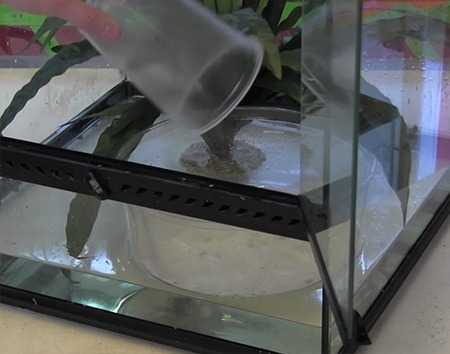
As for how to feed Vietnamese mossy frogs, this is where it gets tricky depending on their tank setup. Since a portion of their tank is water, you should do your best to ensure the crickets don’t jump in the water and die, resulting in less food for your pet and a mess for you to clean up later! I recommend placing the crickets in a small, plastic bowl just big enough to keep them from jumping out. The bowl can float on the water or sit on land where space is available.
Breeding
Within the United States, captive breeding of Vietnamese mossy frogs is on the rise but, unfortunately, there still aren’t very many breeders. This can make purchasing a Vietnamese mossy frog a difficult task, often resulting in steep prices.
This is partially due to the male to female ratio of eggs. Even in the right conditions, a ratio of 1 female to 4 males is most common. Temperature plays a large role in this factor as well; Reports suggest that tadpoles raised in lower temperature water (around 60 degrees Fahrenheit) yield more females than tadpoles kept in water at room temperature. The results, as mentioned above, are roughly 25% female and 75%, male. Tadpoles raised in water at room temperature almost always result in all-male frogs.
Sexing
Determining the sex of young Vietnamese mossy frogs is difficult but as they get older, it becomes more apparent. As with many species of frogs, females are about 20% bigger. Males tend to be smaller with slim bodies and slender hind legs.
The most reliable method of determining the sex of your mossy frog is the nuptial pads. A male Vietnamese mossy frog, when fully matured, has nuptial pads on their front legs which are red or pink in color.
- Females are roughly 20% bigger than males.
- Males have red or pink nuptial pads on their front legs.
It is hard to determine the sex of mossy frogs during the froglet and juvenile stages. I say this so you won’t be surprised if your local breeder can’t guarantee the sex of the frog they’re selling you. Mossy frogs are often sold at young ages when sex has yet to be determined.
Mating
In captivity, the year-round environment doesn’t change so, essentially, you cannot regulate when your frogs will mate. One thing is certain though, the success rate of breeding this species increases when a female has multiple male partners to choose from. Having 2 – 3 males with 1 female in your cage is optimal.
A good indicator that your frogs are ready to mate is when you hear them calling. This most often occurs during the early nighttime hours and just before dawn.
The fertilized eggs are laid just above the waterline and usually in cracks or holes along cork bark or similar features. The will eventually fall into the water and the tadpoles will develop within 14 – 21 days.
Tadpoles & Froglets
In all my research on Vietnamese mossy frogs, I’ve come across two ways to care for tadpoles and froglets. Both of which have been proven successful. The first begins before the tadpoles are fully developed; during the egg stage.
The eggs are removed and placed in a petri dish with a small amount of water. The eggs absorb much of the water and eventually break free and begin swimming around as tadpoles. The second method is to simply leave the eggs in their parent’s cage. Allow the tadpoles to remain there for 2 – 4 weeks before separating them from the parent’s enclosure.
Upon reaching the tadpole stage, it’s best to separate them into small groups of six or eight per container. Each container is filled with about 2 inches of dechlorinated water. Adding an Indian almond leaf will provide shelter and balance the water’s pH levels. Feed the tadpoles a mixture of dried spirulina, crushed crickets, and chlorella algae.
Keep the water temperature in the mid to upper-60s and perform partial water changes one to two times a week. The transition between tadpoles to frogs varies depending on the number of tadpoles in each container. Keepers have reported less time to develop when houses individually as opposed to keeping them in groups. On average, is takes between 4 to 6 months.
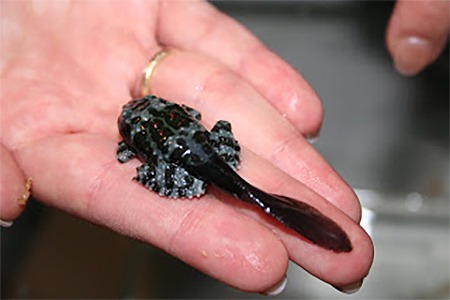
Once your little Theloderma froglet emerges, a small land area should be added to their container. Their container, by the way, should be upgraded as they grow to match their current size. At this point, a shoe-box sized container will suffice. You can also begin feeding them small crickets dusted with vitamin and calcium supplements. Start by feeding them two or three small crickets. Allow your froglet a couple hours of feeding time before removing any crickets left over.
After six months your young Vietnamese mossy frog will have grown to about 2 inches in length. They are now ready to be placed in their full-sized cage.
Handling Your Vietnamese Mossy Frog
Vietnamese mossy frogs are generally considered “display pets”. Handling them can quickly stress your frog which often-times results in their health declining. Having said that, occasionally handling your frog to transfer them from one cage to another is perfectly fine. Find some tips and tricks for handling your mossy frog in our frog handling etiquette guide.
Mossy frogs have been known to be a little jumpy (pun intended). So, to avoid a long fall, be mindful that your little Theloderma pet doesn’t hop out of your hands!
Infographic for Vietnamese Mossy Frogs
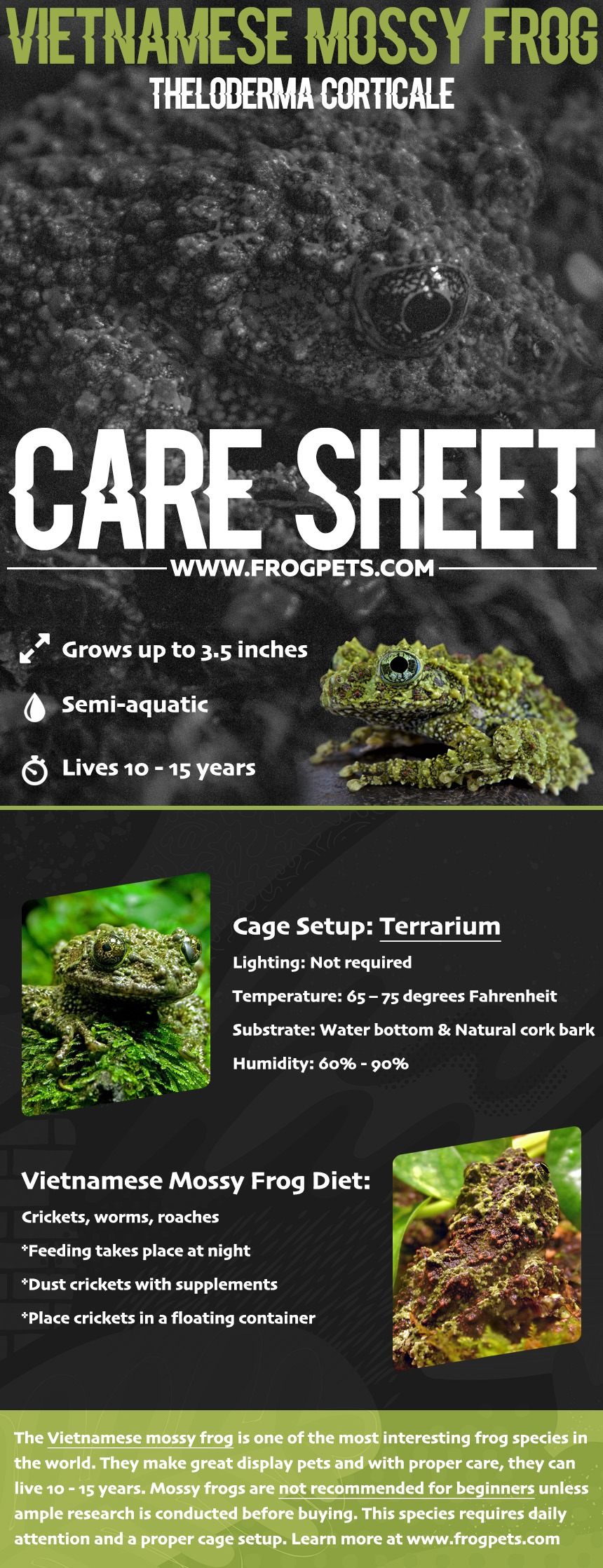

16 Comments
I bought two mossy frogs. Now I have tadpoles. Thank you for the much needed information. I appreciate it.
Oh boy! That’s exciting. Good luck with them!
Im pretty sure I know the answer but can I put mossy frogs in with my bumblebee dart frogs? 40 gal paludarium so set up is almost perfect for them.
No, Sara 🙂
Please don’t put them together. This goes with any species of frogs. They should only be housed with their own kind. This is due to the different toxins in their skin. Because they’re in such a small space, the toxins will inevitably get all over the enclosure. Toxins from different species can be harmful for your little amphibian pets. I hope this helps!
I have an adult mossy that I have now had for over a year. I believe it is a male. He has never been a great eater and has never shown much of a food response and although I have never noticed him to be unhealthy or underweight he seems to be getting worse with food over time. I have tried every way I can think of to offer food. I gave him a 2% UVB bulb which helped his appetite briefly but not in the long term since it has dropped again. I am wondering, would he eat better and be happier if he were in a group? I can never find information on whether or not they benefit from being in groups vs being housed alone but I know that is true of many frog species. Any advice would be appreciated. Thanks!
What are you feeding him? If you’re offering live crickets, are you also dusting them with supplements? (calcium and vitamins)
I have 2 mossy frogs, I fed them both before I went to bed last night and they were both in their cage. I came down this morning and there is only 1 frog in there, I have taken everything out of the enclosure and done a thorough search but still no where to be seen. Do you have any idea what could’ve happened? It’s very unlikely it would’ve escaped as the enclosure is very secure, if it did manage to get out is there anywhere in particular that it would be? Have searched the whole house and still found nothing 🙁
Sorry to hear that! They have such good camouflage it would be hard to find. Check near any source of moisture in your house. I hope you find him!
Hi! I’m planning on getting a mossy frog, myself. Is it recommended to get more than one, or will it be ok just to have one on it’s own ?
One will do fine on its own but you will probably be happier with two!
I have 2 mossy frogs, I fed them both before I went to bed last night and they were both in their cage. I came down this morning and there is only 1 frog in there, I have taken everything out of the enclosure and done a thorough search but still no where to be seen. Do you have any idea what could’ve happened? It’s very unlikely it would’ve escaped as the enclosure is very secure, if it did manage to get out is there anywhere in particular that it would be? Have searched the whole house and still found nothing 🙁
Any chance one frog will kill another. I came down today to find the smaller of two frogs dead in the cricket bowl. Older one was 2 yrs. Younger 1yr.
It actually is the second smaller frog dead. Could it be over food? Or could it be after mating?
Sorry to hear that. I’ve heard of more aggressive species killing each other but not mossy frogs. I’m not saying it isn’t possible though. What is the size difference? I imagine even around 1 year old it was nearing its full size.
I have a large mossy frog 4” in length 8 months old which I believed to be female due to size but it calls through the night , I’ve since bought another 4 at 1” in size in two months two of them have reached almost 2” the other two are 1 1/2” and just over 1 1/2” and one or more of them have started to call but a much fainter sound they feed very well even with the light on
Saw these guys for the very first time this past Saturday at ReptiCon in Chalmette, LA. $75 and they were extraordinary! Didn’t buy any, though.
Hey Angelo! That’s awesome. I agree, they’re definitely extraordinary frogs! One of my all-time favorites.